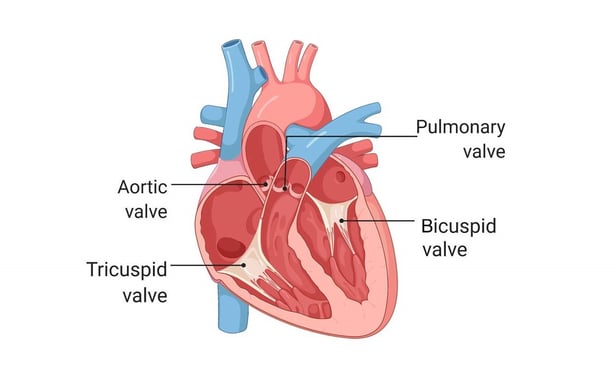Valvular heart disease
Empowering people with knowledge






The heart contains four valves that control the back flow of blood within the Cardiac chambers during contraction and pumping, The left side of the heart contains the Mitral valve, which divides the left atrium from the left ventricle, and the Aortic valve, which controls blood pumped by the ventricle into the Aorta which supplies the whole body with oxygenated blood.The right side also contains two; the tricuspid valve which lies between the right atrium and ventricle, and the pulmonary valve which controls blood being pumped by the ventricle into the pulmonary artery and to the lungs to be oxygenated.


Mitral
valve
When one or more of these valves become diseased or damaged, it can lead to valvular heart disease (VHD), a condition that affects millions worldwide.
While some cases of VHD may be mild and manageable, severe cases require medical intervention, ranging from medications to surgical procedures. Understanding the condition, its symptoms, and available treatments can help individuals living with VHD maintain a good quality of life and prevent complications.
What is Valvular Heart Disease?
Valvular heart disease occurs when one or more heart valves become diseased or dysfunctional. This can result from congenital defects, infections, aging, or other medical conditions such as rheumatic fever or endocarditis. There are three main types of valve dysfunction:
Stenosis – The valve becomes narrowed and does not open fully, restricting blood flow.
Regurgitation (or insufficiency) – The valve does not close properly, causing blood to leak backward.
Atresia – A rare congenital condition where a valve is missing or does not develop properly.
The most commonly affected valves are the aortic and mitral valves, though any of the four can be impacted.
Symptoms of Valvular Heart Disease
Symptoms of VHD vary depending on the severity of the condition. Some individuals with mild disease may experience no symptoms at all, while others with advanced disease may struggle with daily activities. Common symptoms include:
Shortness of breath, especially with exertion or when lying down
Fatigue and weakness
Chest pain or discomfort
Irregular heartbeat (arrhythmia) or palpitations
Dizziness or fainting
Swelling in the legs, feet, or abdomen (edema)
Because symptoms often develop gradually, individuals may not recognize the severity of their condition until it significantly affects their daily life.
Living with Valvular Heart Disease
For many people, living with VHD requires lifestyle modifications and regular medical monitoring. Here are some key ways to manage the condition:
1. Medication Management
While medications cannot cure VHD, they can help manage symptoms and prevent complications. Common medications include:
Diuretics to reduce fluid buildup and swelling.
Beta-blockers or calcium channel blockers to control heart rate and blood pressure.
Anticoagulants (blood thinners) to prevent blood clots, especially in individuals with atrial fibrillation or mechanical heart valves.
ACE inhibitors or angiotensin receptor blockers (ARBs) to reduce strain on the heart.
2. Heart-Healthy Lifestyle
Adopting a heart-healthy lifestyle can slow disease progression and improve overall well-being:
Eat a balanced diet rich in fruits, vegetables, lean proteins, and whole grains while minimizing salt, saturated fats, and processed foods.
Exercise regularly with low-impact activities like walking, cycling, or swimming, as advised by a doctor.
Avoid smoking and excessive alcohol consumption, as they can worsen heart health.
Monitor symptoms and attend regular check-ups to track disease progression and adjust treatment as needed.
When Valvular Heart Disease Becomes Severe
As VHD progresses, symptoms may worsen, impacting daily life and increasing the risk of heart failure. At this stage, advanced treatments are often necessary.
1. Balloon Valvuloplasty
This minimally invasive procedure is used primarily for stenosis. A catheter with a small balloon is inserted into the narrowed valve and inflated to widen the opening. While effective for some, it is usually a temporary solution, and the valve may narrow again over time.
2. Valve Repair Surgery
In some cases, the existing valve can be repaired instead of replaced. Surgical repair may involve reshaping valve leaflets, reinforcing the valve ring (annuloplasty), or removing calcium deposits. Valve repair is preferred over replacement when possible because it preserves the natural valve structure and reduces the need for long-term anticoagulation therapy.
3. Valve Replacement Surgery
When repair is not an option, the diseased valve must be replaced with either:
Mechanical valves (made of durable materials like metal or carbon), which last a lifetime but require lifelong blood thinners.
Biological valves (made from human or animal tissue), which do not require blood thinners but may wear out over time and need replacement.
Valve replacement can be performed via traditional open-heart surgery or through a less invasive method called transcatheter aortic valve replacement (TAVR), which is suitable for high-risk patients who may not tolerate open surgery.
4. Transcatheter Mitral Valve Repair (TMVR)
For patients with severe mitral regurgitation who are not candidates for surgery, TMVR procedures like MitraClip can help reduce blood leakage without the need for open-heart surgery.
Outlook and Quality of Life
With proper management and timely intervention, many individuals with valvular heart disease can lead fulfilling lives. Advances in treatment, including minimally invasive procedures, have significantly improved outcomes and reduced recovery times.
The key to successful management is early detection and proactive care. Regular heart check-ups, adherence to prescribed treatments, and making healthy lifestyle choices can make a substantial difference in maintaining heart function and overall well-being.
Conclusion
Valvular heart disease is a serious condition, but it does not have to be a life sentence. By staying informed, seeking appropriate medical care, and adopting a heart-healthy lifestyle, individuals with VHD can continue to enjoy life while managing their condition effectively. If you or a loved one experiences symptoms of VHD, do not ignore them—early diagnosis and treatment can save lives.
